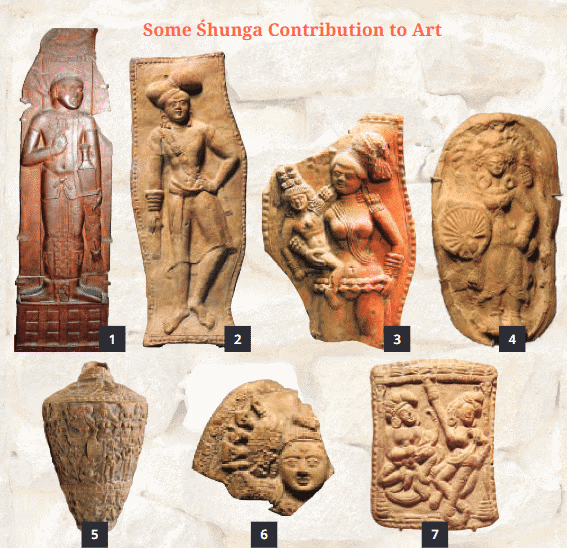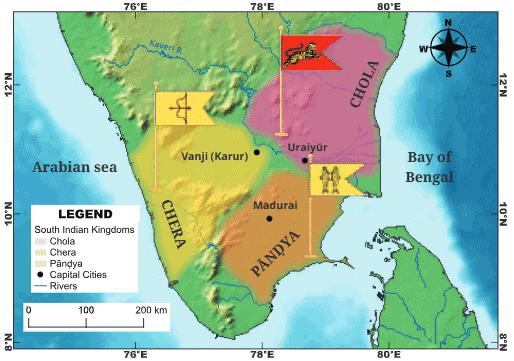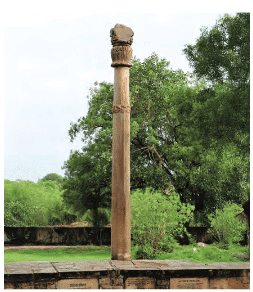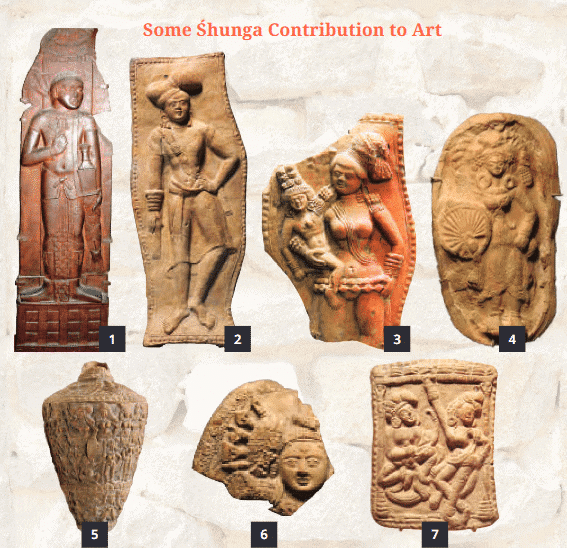VSAQ for Chapter 6 The Age of Reorganization Class 7 Social Science NCERT
Important Questions1
Q1: Who founded the Śhunga dynasty?
Answer
The Śhunga dynasty was founded by Puṣhyamitra Śhunga in 185 BCE.
VSAQ
2
Q2: What ritual did Puṣhyamitra Śhunga perform to claim unchallenged lands?
Answer
Puṣhyamitra Śhunga performed the ashvamedha yajña, a Vedic ritual involving a horse.
VSAQ
3
Q3: How long did the Śhunga Empire last?
Answer
The Śhunga Empire lasted for about a century before declining.
VSAQ
4
Q4: What language became important during the Śhunga period?
Answer
Sanskrit became an important language for philosophy and literature during the Śhunga period.
VSAQ
5
Q5: Which stūpa was enriched with carvings during the Śhunga period?
Answer
The Bharhut Stūpa was enriched with carvings during the Śhunga period.
VSAQ
6
Q6: What did the Śhungas contribute to art?
Answer
The Śhungas contributed to carvings depicting stories from Buddha’s life and other cultural elements.
Shunga Contribution to Art
VSAQ
7
Q7: Which region did the Sātavāhanas rule?
Answer
The Sātavāhanas ruled the Deccan region, including present-day Andhra Pradesh, Telangana, and Maharashtra.
VSAQ
8
Q8: What were two key capitals of the Sātavāhanas?
Answer
The Sātavāhanas’ capitals were Amrāvatī and Pratiṣhṭhāna (Paithan).
VSAQ
9
Q9: What goods did the Sātavāhanas trade with the Roman Empire?
Answer
The Sātavāhanas traded spices, textiles, gold-plated pearls, and ivory with the Roman Empire.
VSAQ
10
Q10: How did the Sātavāhanas promote trade?
Answer
The Sātavāhanas promoted trade through their strong maritime connections and trade routes.
VSAQ
11
Q11: What is the significance of the Naneghat Caves in Sātavāhana history?
Answer
The Naneghat Caves were used for collecting tolls and as rest stops for traders.
VSAQ
12
Q12: What is Sangam literature?
Answer
Sangam literature refers to Tamil poems composed during the Sangam Age, reflecting society and culture.
Sangam Period
VSAQ
13
Q13: Which south Indian kingdoms existed during the Sangam Age?
Answer
The Cheras, Cholas, and Pāṇḍyas were the prominent kingdoms during the Sangam Age.
VSAQ
14
Q14: Who defeated the Cheras and Pāṇḍyas to become a powerful ruler?
Answer
King Karikāla defeated the Cheras and Pāṇḍyas to become a powerful ruler of the Chola dynasty.
VSAQ
15
Q15: What was the Kallanai built by Karikāla?
Answer
The Kallanai, or Grand Anicut, was a water diversion system built by Karikāla to irrigate the Kāveri River delta.
VSAQ
16
Q16: What is the story of Kannagi in the Silappadikāram?
Answer
Kannagi’s story in the Silappadikāram tells of her quest for justice after her husband Kovalan was wrongfully executed by the Pāṇḍya king.
VSAQ
17
Q17: What was the role of the Cheras in trade?
Answer
The Cheras facilitated trade by exporting spices, timber, ivory, and pearls to the Roman Empire and West Asia.
Chera, Chola, Pandya
VSAQ
18
Q18: What did the Pāṇḍyas trade with the Greeks and Romans?
Answer
The Pāṇḍyas traded pearls and other goods with the Greeks and Romans.
VSAQ
19
Q19: Who is Khāravela, and what was his significance?
Answer
Khāravela was the ruler of the Chedi dynasty in Kalinga, known for promoting Jainism and his fair governance.
VSAQ
20
Q20: What is the significance of the Udayagiri-Khandagiri Caves?
Answer
The Udayagiri-Khandagiri Caves, built for Jain monks, feature detailed carvings and spacious rooms.
VSAQ
21
Q21: What role did the Indo-Greeks play in Indian history?
Answer
The Indo-Greeks ruled parts of northwest India, blending Greek and Indian cultures in art, governance, and daily life.
VSAQ
22
Q22: What is the Heliodorus pillar?
Answer
The Heliodorus pillar near Vidisha was built by a Greek ambassador and praises Vāsudeva as the "god of gods."
Heliodorus Pillar Near Vidisha
VSAQ
23
Q23: Who were the Kuṣhāṇas, and where did they rule?
Answer
The Kuṣhāṇas were Central Asian rulers who controlled northern India and parts of Central Asia.
VSAQ
24
Q24: What was the significance of Kuṣhāṇa coins?
Answer
Kuṣhāṇa coins depicted kings and deities like Vāsudeva-Kṛiṣhṇa and were used to support trade.
VSAQ
25
Q25: What is the legacy of Gāndhāra and Mathurā art?
Answer
Gāndhāra and Mathurā art combined Greek and Indian styles, depicting gods and goddesses with realistic figures and detailed robes.
VSAQ
26
Q26: Who founded the Śhunga dynasty?
Answer
Puṣhyamitra Śhunga.
VSAQ
27
Q27: What were the Sātavāhana rulers known for in terms of trade?
Answer
They had strong maritime trade, trading spices and textiles.
VSAQ
28
Q28: Which ruler promoted Jainism in the Chedi dynasty?
Answer
Khāravela.
VSAQ
29
Q29: Where did the Indo-Greeks establish their presence in India?
Answer
Northwest India.
VSAQ
30
Q30: What was the major contribution of the Kuṣhāṇas to Indian art?
Answer
Gandhara and Mathura art styles.
Shunga Contribution to Art
VSAQ